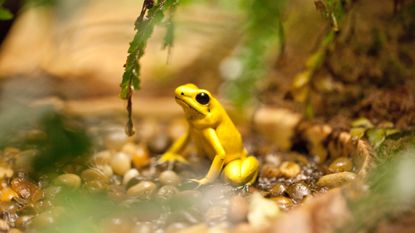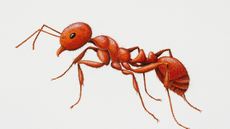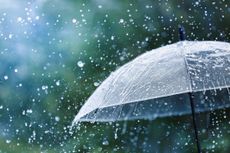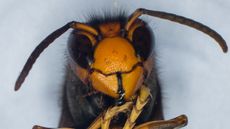Why frogs and other amphibious 'climate captives' are 'the world's most threatened animals'
Endangered mammals and birds get a lot of attention, but amphibians are faring much worse in this hotter world


A free daily digest of the biggest news stories of the day - and the best features from our website
Thank you for signing up to TheWeek. You will receive a verification email shortly.
There was a problem. Please refresh the page and try again.
More than 40% of the world's frog, salamander and other amphibious species are threatened with extinction, researchers reported Wednesday in the journal Nature. The comprehensive survey of global amphibious populations found that things have gotten worse for the cold-blooded vertebrates since the International Union for Conservation of Nature conducted its first headcount in 2004.
The nearly 41% of endangered amphibian species compares with 27% of mammals, 21% of reptiles and 13% of birds, the study said. "Amphibians are the world's most threatened animals," Duke University frog researcher Junjie Yao, who was not involved in the study, told The Associated Press.
The biggest threat to amphibians remains the loss of habitat to farming and ranching, the study found, but climate change is a growing peril.
Subscribe to The Week
Escape your echo chamber. Get the facts behind the news, plus analysis from multiple perspectives.

Sign up for The Week's Free Newsletters
From our morning news briefing to a weekly Good News Newsletter, get the best of The Week delivered directly to your inbox.
From our morning news briefing to a weekly Good News Newsletter, get the best of The Week delivered directly to your inbox.
"As humans drive changes in the climate and to habitats, amphibians are becoming climate captives, unable to move very far to escape the climate change-induced increase in frequency and intensity of extreme heat, wildfires, drought, and hurricanes," Jennifer Luedtke Swandby, a lead author of the study, said in a statement.
Amphibians have different life stages that require separate habitats, so a disruption to any of their environments is dangerous. And their delicate skin, which many amphibians use to breathe, makes them especially vulnerable to drought, pollution and fungal or bacterial infections. Amphibians "lack the scales, fur and feathers of other animals to help regulate their temperature and moisture levels in this hotter and more drought-stricken world," The Washington Post reported.
"Amphibians are disappearing faster than we can study them," said Re:wild's Kelsey Neam, another lead author, "but the list of reasons to protect them is long, including their role in medicine, pest control, alerting us to environmental conditions and making the planet more beautiful." And while frogs and other amphibians may be "overlooked compared to more well-known groups like birds and mammals," Neam added, "we will see this collapse of the food web" if they vanish.

Continue reading for free
We hope you're enjoying The Week's refreshingly open-minded journalism.
Subscribed to The Week? Register your account with the same email as your subscription.
Sign up to our 10 Things You Need to Know Today newsletter
A free daily digest of the biggest news stories of the day - and the best features from our website
Peter Weber is a senior editor at TheWeek.com, and has handled the editorial night shift since the website launched in 2008. A graduate of Northwestern University, Peter has worked at Facts on File and The New York Times Magazine. He speaks Spanish and Italian and plays bass and rhythm cello in an Austin rock band. Follow him on Twitter.
-
 Ben Fountain's 6 favorite books about Haiti
Ben Fountain's 6 favorite books about HaitiFeature The award-winning author recommends works by Marie Vieux-Chauvet, Katherine Dunham and more
By The Week Staff Published
-
 6 picturesque homes in apartments abroad
6 picturesque homes in apartments abroadFeature Featuring a wall of windows in Costa Rica and a luxury department store-turned-home in New Zealand
By The Week Staff Published
-
 Why 2023 has been the year of strikes and labor movements
Why 2023 has been the year of strikes and labor movementsThe Explainer From Hollywood to auto factories, workers are taking to the picket lines
By Justin Klawans Published
-
 Why New York City was caught off guard by flash flooding
Why New York City was caught off guard by flash floodingTalking Point Is climate change moving too fast or are city leaders dragging their feet?
By Theara Coleman Published
-
 The red fire ant invasion 'creeping closer' to London
The red fire ant invasion 'creeping closer' to LondonDeadly insect considered one of world's most invasive species has been spotted in Europe for first time
By Chas Newkey-Burden Published
-
 6 of the most invasive species on the planet
6 of the most invasive species on the planetSpeed Read Invasive species are a danger to ecosystems all over the world
By Devika Rao Published
-
 Air pollution is now the 'greatest external threat' to life expectancy
Air pollution is now the 'greatest external threat' to life expectancySpeed Read Climate change is worsening air quality globally, and there could be deadly consequences
By Devika Rao Published
-
 How climate change is impacting the water cycle
How climate change is impacting the water cycleSpeed Read Rain will likely continue to be unpredictable
By Devika Rao Published
-
 Asian hornets threaten ‘catastrophe’ for UK bees
Asian hornets threaten ‘catastrophe’ for UK beesSpeed Read Invasive species is gaining ‘foothold’ in southern England with ‘sharp rise’ in sightings
By Chas Newkey-Burden Published
-
 What is carbon capture?
What is carbon capture?feature The U.S. is investing in technologies that keep CO2 out of industrial emissions — or that remove it from the atmosphere
By The Week Staff Published
-
 Why spotted lanternflies are back and worse than ever
Why spotted lanternflies are back and worse than everSpeed Read It's time to get squashing!
By Devika Rao Published










